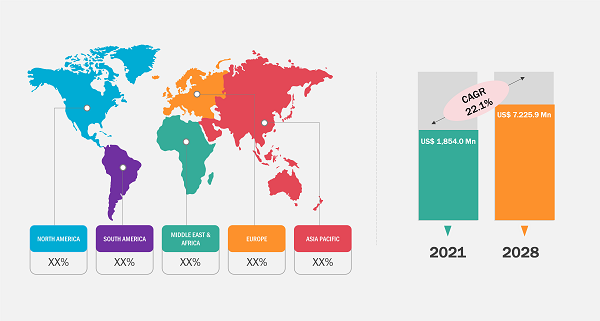Rising Demand for Solutions to Process Low-Latency Queries Catalyzes Graph Database Market
According to our latest market study on "Graph Database Market Forecast to 2028 – COVID-19 Impact and Global Analysis – by Component, Deployment Type, Application, Type, Industry Vertical, and Geography," the graph database market is expected to grow from US$ 1,854.0 million in 2021 to US$ 7,225.9 million by 2028; it is estimated to grow at a CAGR of 22.1% from 2022 to 2028.

Graph Database Market Analysis by Size, Share & Growth 2031
Download Free SampleGraph Database Market Size and Forecast (2021 - 2031), Global and Regional Share, Trend, and Growth Opportunity Analysis Report Coverage: By Component (Software, Services), Deployment Type (On-Premise, Cloud), Application (Risk Management and Fraud Detection, Customer Analytics, Recommendation Engines, Supply Chain Management, Operations Management and Asset Management, Knowledge Management, Scientific Data Management, Others), Type (Property Graph, Resource Description Framework), Industry Vertical (BFSI, Healthcare, Telecom and IT, Retail and E-commerce, Transportation and Logistics, Government and Public Sector, Media and Entertainment, Travel and Hospitality, Manufacturing, Others), and Geography
With the widespread adoption of graph database solutions and services, some vendors of legacy database technologies are attempting to layer graph database schemas on top of their relational database designs. In practice, the method can restrict and compromise the performance of the queries launched against the database, even though the approach may reduce costs in theory. A graph database is changing conventional brick-and-mortar businesses into digital business powerhouses regarding digital business initiatives. Many companies face issues placing a large amount of connected data in a database that is not optimized for any desired use. Graph database performs significantly better than conventional relational databases when matching historical and session data by uniquely querying past customer purchases during an online visit. Graphs database provides lower latency. Millions of related records can be traversed within a constant response time regardless of database size because of the nodes and links ‘point’ to one another. To achieve low latency and high throughput, queries are split into sub-queries that run concurrently.
In the healthcare & life sciences industry, graph database software is essential for recording patients’ information and disseminating it to numerous patients or healthcare providers. Startups in the healthcare industry are using graph database technology to meet customers' unmet needs. For instance, Zephyr Health, a health-focused startup, is leveraging graph database technology as a key part of its service offerings. Zephyr Health uses Neo4j to enable its cloud-based Zephyr analytics platform, providing graph analytics across a diversity of healthcare data. Additionally, healthcare institutions and organizations are utilizing graph database tools to boost operational efficiency and safety, cut costs, and enhance patient care quality, fueling the demand for graph database solutions in the healthcare industry. Further, healthcare organizations utilize the connections within their existing data, such as information about patient treatments or connected genomes, by using graph database technology, which is advantageous for the graph database market.
The global graph database market is segmented on the basis of component, deployment type, application, type, and industry vertical. Based on component, the graph database market is segmented into software and services. By deployment type, the graph database market is bifurcated into cloud and on-premise. Based on application, the graph database market is segmented into risk management and fraud detection, customer analytics, recommendation engines, supply chain management, operations and asset management, knowledge management, scientific data management, and others. Based on type, the graph database market is segmented into property graph and resource description framework. Based on industry vertical, the graph database market is segmented into BFSI, healthcare, telecom and IT, retail and e-commerce, transportation and logistics, government and public sector, media and entertainment, travel and hospitality, manufacturing, and others.
Amazon Web Services, Inc.; Callidus Software Inc.; IBM Corporation; Microsoft Corporation; MarkLogic Corporation; Neo4j, Inc.; Oracle Corporation; OpenLink Software; Teradata Corporation; and TIBCO Software Inc. are among the key graph database market players profiled during the study. Several other major companies were studied and analyzed during this research study to get a holistic view of the graph database market and its ecosystem.
Contact Us
Phone: +1-646-491-9876
Email Id: sales@theinsightpartners.com